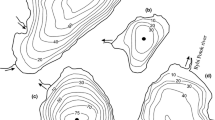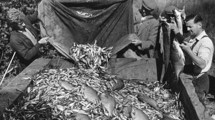Abstract
The effects of fish stock reduction have been studies in 3 Dutch lakes (Lake Zwemlust, Lake Bleiswijkse Zoom and Lake Noorddiep) and 1 Danish lake (Lake Væng) during 4–5 years. A general response id described. The fish stock reduction led in general to a low fish stock, low chlorophyii-a, high transparency and high abunuance of macrophytes. Large Daphnia became abundant, but their density decreased, due to food limitation and predation by fish. The total nitrogen concentration became low due to N-uptake by macrophytes and enhanced denitrification. In Lake Bleiswijkse Zoom the water transparency deteriorated and the clear water state was not stable. The fish stock increased and the production of young fish in summer was high. lear water occurred only in spring. Large daphnids were absent in summer and the macrophytes decreased.
In Lake Zwemlust, Lake Væng and Lake Noorddiep the water remained clear during the first five years. In summer of the sixth year (1992) transparency decreased in Lake Zwemlust (with high P-concentration of 1.0 mg P l-1). Also in Lake Væng (with a low nutrient concentration of 0.15 mg P.⋆-1) a short term turbid stage (1.5 month) occurred in summer 1992 after a sudden collapse of the macrophytes. Deterioration of the water quality seems to start in summer and seems related to a collapse in macrophytes. At a low planktivorous fishstock (e.g. Lake Væng)thhe duration of the turbid state is shorter. than in presence of a high planktivorous fish biomass (e.g. Lake Zwemlust, and later years of Lake Bleiswijkse Zoom).
Similar content being viewed by others
References
Benndorff, J., 1987. Food-web manipulation without nutrient control: a useful strategy in lake restoration? Schweiz. Z. Hydrol. 49: 237–248.
Blindow, I., 1992. Long- and short-term dynamics of submerged macrophytes in two shallow eutrophic lakes. Freshwat. Biol. 28: 15–27.
Grimm, M. P. & J. J. G. M. Backx, 1990. The restoration of shallow eutrophic lakes, and the role of northern pike, aquatic vegetation and nutrient concentration. Hydrobiologia 200–201/Dev. Hydrobiol. 61: 557–566.
Gulati, R. D., 1990. Structural and grazing response of zooplankton community to biomanipulation in Dutch water bodies. Hydrobiologia 200–201/Dev. Hydrobiol. 61: 99–118.
Havens, K. E., 1993. Response to experimental fish manipulations in a shallow, hypereutrophic lake: the relative importance of benthic nutrient recycling and trophic cascade. Hydrobiologia 254: 73–80.
Jeppesen, E., M. Søndergaard, E. Mortensen, P. Kirstensen, B. Riemann, H. J. Jensen, J. P. Muller, O. Sortkjaer, J. P. Jensen, K. Christoffersen, S. Bosselmann & E. Dall, 1990. Fish manipulation as a lake restoration tool in shallow eutrophic temperate lakes 1: cross-analysis of three Danish case-studies. Hydrobiologia 200–201/Dev. Hydrobiol. 61: 205–218.
Jeppesen, E., J. P. Jensen, P. Kristensen, M. Søndergaard, E. Mortensen, O. Sortkjær & K. Olrik, 1990. Fish manipulation as a lake restoration tool in shallow, eutrophic, temperate lakes 2: threshold levels, long-term stability and conclusions. Hydrobiologia 200–201/Dev. Hydrobiol. 61: 219–227.
Jeppesen, E. P. Kristensen, J. P. Jensen, M. Søndergaard, E. Mortensen & T. Lauridsen, 1991. Recovery resilience following a reduction in external phosphorus loading of shallow eutrophic Danish lakes: duration, regulation factors and methods for overcoming resilience. Mem. Ist. ital. Idrobiol. 48: 127–148.
Lauridsen, T. L., E. Jeppesen & M. Søndergaard, 1994. Colonization and succession of submerged macrophytes in shallow Lake Væng during the first five years following fish manipulation. Hydrobiologia 275–276/Dev. Hydrobiol. 94: 233–242.
Meijer, M-L., M. W. de Haan, S. W. Breukelaar & H. Buiteveld, 1990. Is reduction of benthivorous fish an important cause of high transparency following biomanipulation in shallow lakes? Hydrobiologia 200–201/Dev. Hydrobiol. 61: 303–316.
Moss, B., 1990. Engineering and biological approaches to the restoration from eutrophication of shallow lakes in which aquatic plant communities are important components. Hydrobiologia 200–201/Dev. Hydrobiol. 61: 367–378.
Ozimek, T., E. van Donk & R. D. Gulati, 1990. Can macrophytes be useful in biomanipulation of lakes. Hydrobiologia 200–201/Dev. Hydrobiol. 61: 475–487.
Perrow, M. R., B. Moss & J. Stansfield, 1994. Trophic interactions in a shallow lake following a reduction in nutrient loading: a long-term study. Hydrobiologia 275–276/Dev. Hydrobiol. 94: 43–52.
Phillips, Y., L. Eminson & B. Moss, 1978. A mechanism to account for macrophyte decline in progressively eutrophicated fresh waters. Aquat Bot. 4: 103–126.
Reinertsen, H. A. & Y. Olsen, 1984. Effects of fish elimination on the phytoplankton community of an eutrophic lake. Verh. int. Ver. Limnol. 22: 649–657.
Sarnelle, O., 1992. Nutrient enrichment and grazer effects on phytoplankton in lakes. Ecology 73: 551–560.
Scheffer, M., 1990. Multiplicity of stable states in freshwater systems. Hydrobiologia 200–201/Dev. Hydrobiol. 61: 475–486.
Shapiro, J., V. Lamarra & M. Lynch, 1975. Biomanipulation: an ecosystem approach to lake restoration. In: P. L. Brezonik & J. F. Fox (eds), Water Quality management through biological control. Univ. of Florida, Gainesvill, Florida, Usa: 85–96.
Sondergaard, M., E. Jeppesen, E. Mortensen, E. Dall, P. Kristensen & O. Sørtkjaer, 1990. Phytoplankton biomass reduction after planktivorous fish reduction in a shallow, eutrophic lake: a combined effect of reduced internal P-loading and increased zooplankton grazing. Hydrobiologia 200–201/Dev. Hydrobiol. 61: 229–240.
Van Donk, E., M. P. Grimm, R. D. Gulati & J. P. G. Klein Breteler, 1990. Whole-lake food-web manipulation as a means to study community interactions in a small ecosystem. Hydrobiologia 200–201/Dev. Hydrobiol. 61: 275–291.
Van Donk, E., R. D. Gulati, A. Iedema & J. T. Meulemans, 1993. Macrophyte-related shifts in the nitrogen and phosphorus contents of the different trophic levels in a biomanipulated shallow lake. Hydrobiologia 251/Dev. Hydrobiol. 82: 19–26.
Van Donk, E., E. de Deckere, J. P. G. Kleine Breteler & J. T. Meulemans (in press). Herbivory by waterfowl and fish on macrophytes in a biomanipulated lake: effects on long-term recovery. Verh. int. ver. Limnol. 25.
Vanni, M. J. & D. L. Findlay, 1990. Trophic cascades and phytoplankton community structure. Ecology 71: 921–937.
Author information
Authors and Affiliations
Rights and permissions
About this article
Cite this article
Meijer, M.L., Jeppesen, E., van Donk, E. et al. Long-term responses to fish-stock reduction in small shallow lakes: interpretation of five-year results of four biomanipulation cases in The Netherlands and Denmark. Hydrobiologia 275, 457–466 (1994). https://doi.org/10.1007/BF00026734
Issue Date:
DOI: https://doi.org/10.1007/BF00026734




